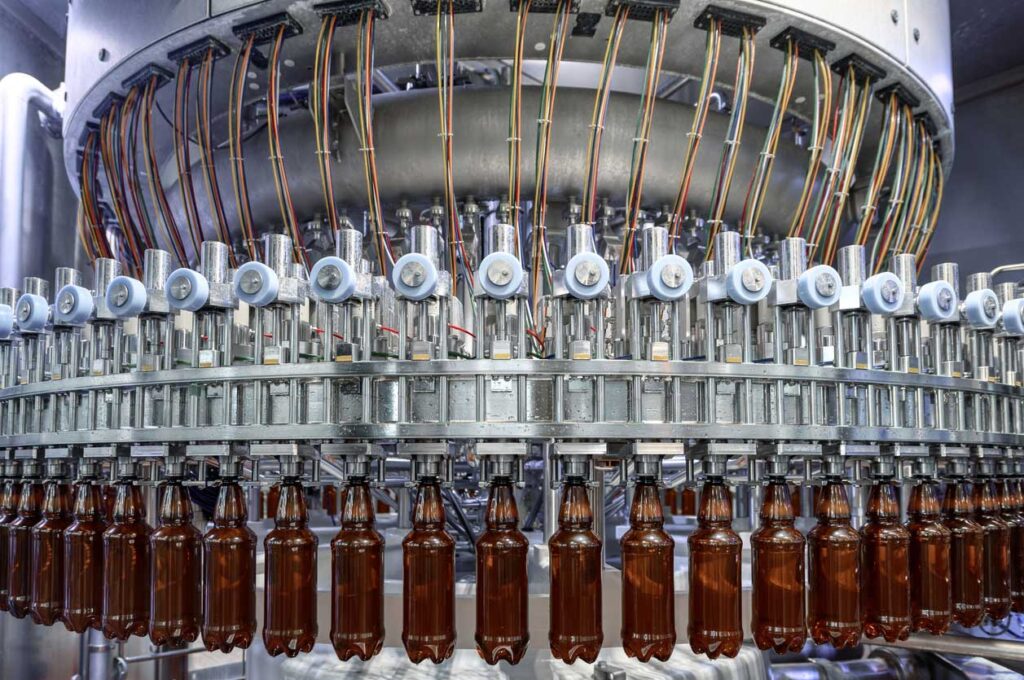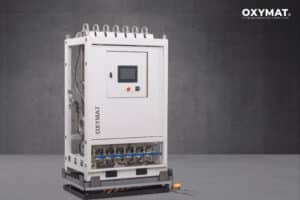Table of Contents
- The process of wastewater treatment and the role of oxygen
- Advantages of having oxygen gas-generators in water treatment plant
- Oxygen gas generator providers (OXYMAT – Onsite oxygen gas generators)
In-house oxygen gas generators have transformed the wastewater treatment process by ensuring a steady and effective oxygen source right at the treatment sites. Essential for the biological decomposition phase, oxygen generating systems improve the breakdown of organic matter and support the growth of beneficial microorganisms. Oxygen generating machines offer significant advantages as they remove reliance on external oxygen supplies, delivering substantial benefits such as continuous operation, reduced expenses, and eco-friendly impacts.
Onsite oxygen gas generators have revolutionized the approach to wastewater treatment, offering a dependable and highly efficient solution for producing oxygen directly at the treatment plant. They have become necessary for many treatment plants, serving not only as a primary source of oxygen but also as a vital backup system and ozone generation. The process is divided in three main stages, primary (solid removal), secondary (bacterial decomposition), and tertiary (additional filtration).
Oxygen is mainly used in the secondary treatment stage also known as biological treatment stage. In this stage, dissolved oxygen, or the amount of oxygen in the water helps breaking down organic matter and promotes the growth of beneficial microorganisms. This process is also known as oxygenation or aeration. In addition to the second stage, Oxygen can also be used in the tertiary stage to produce Ozone (O3) gas as well. Whether through bulk delivery or onsite generation, a continuous supply of oxygen is of paramount importance.

The process of wastewater treatment and the role of oxygen
The process of is crucial for water purification and involves complex series of steps. The initial steps of collection of waters from private homes, business, and industries are removal of large fragments, such as sticks, stones, plastics, and other solid materials that could damage the facility equipment and create clogging in the plant systems.
Upon completion of the initial steps, starts the primary stage where physical processes like sedimentation and flotation are employed to remove solids and organic matter. Here, gravity settling tanks allow heavy particles to settle to the bottom as sludge, while lighter materials, such as grease and oils, float to the surface and are scraped off. It is after this stage that oxygen input becomes of great importance.
- Secondary stage: During the secondary stage, known as biological treatment, microorganisms are introduced to the water to break down organic pollutants. Here oxygen facilitates aerobic digestion processes and prevent anaerobic conditions, thus, to create an oxygen-rich environment that promotes growth and activity for microorganisms, continuous supply of oxygen is necessary. This stage takes place in large tanks or basins where distributed oxygen is either supplied by traditional methods such as bulk delivery method, or through onsite oxygen gas generators.
- Tertiary stage: In the tertiary stage, also known as advanced or tertiary treatment, additional filtration processes are employed to further remove contaminants and achieve higher levels of water purification. This stage will either include chemical disinfection methods, such as chlorination or ultraviolet (UV) radiation, or ozone (O3). Ozone gas helps to filtrate and remove remaining pathogens or microorganisms, such as viruses and bacteria. The production of ozone and the role of oxygen gas generators in this stage will be further discussed here: Ozone generation in wastewater treatment plants: exploring the significance of oxygen in the tertiary stage
Before the processed water is discharged, water treatment process continues with stage 4 and 5, which involves the management of accumulated layer of sludge from earlier stages. Water can also undergo additional disinfection to ensure compliance with regulatory standards before being released. However, these processes are beyond of our current focus.

Advantages of having oxygen gas-generators in water treatment plant
Implementing oxygen gas generators as a solution in wastewater treatment plants offers numerous advantages that can contribute to efficient and cost-effective operations. They provide a reliable and continuous supply of oxygen, eliminating external sources, which ensures uninterrupted treatment processes and minimizes the risk of oxygen shortages. In contrast, relying on bulk delivery of oxygen can be accompanied with challenges in terms of complexity, cost and subject to potential supply chain disruptions. To further explore these advantages, the table below highlights the key benefits of having oxygen gas generators in a treatment plant.
| Onsite Oxygen Production | Bulk Delivery of Oxygen | |
| Reliability: | Onsite oxygen production eliminates the need for reliance on external suppliers, ensuring a continuous and reliable oxygen supply. | Reliance on external suppliers can lead to potential supply chain disruptions or delays. |
| Cost: | Onsite production eliminates transportation and delivery costs associated with supplied oxygen, resulting in potential cost savings over time. Onsite oxygen production is unaffected by market price fluctuations. | The overall cost of supplied oxygen, including delivery and rent fees, can be higher compared to onsite production in the long run. Supplied oxygen is affected by market price fluctuations |
| Control: | Onsite production allows for greater control over the oxygen supply, allowing adjustments based on specific requirements. | Plants relying on supplied oxygen have limited control over the quality and purity of the oxygen being delivered. |
| Environment: | Onsite production reduces the carbon footprint associated with transportation and storage of supplied oxygen. | The transportation of supplied oxygen contributes to carbon emissions and environmental footprint. |
| Storage: | Compact design to fit within the available space at the treatment plant (often modular settings). | Facilities need to manage and maintain oxygen storage tanks, which can occupy valuable space and require proper handling protocols. |
| Transportation and safety: | Minimal transportation involved, reducing the risk of accidents during transfer. | Handling and frequent transport of oxygen can pose risks to personnel if proper safety protocols are not followed. |
The decision on which option to choose will still depend on the specific needs and circumstances of the w plants. However, with global temperatures on the rise, raising air pollution and overall demand increase for oxygen in other industries, such as healthcare industry (e.g., COVID pandemic), there is a growing recognition of the importance of reliable and continuous oxygen supply.
According to Data Bridge Market Research (June 2023 report), the industrial oxygen market is projected to experience significant growth and reach a value of USD 125,031.34 million by 2029, with a CAGR of 8.50% during the forecast period. A growth to be attributed to the increase in demand in Asia-Pacific and North America (ref). It is expected that the anticipated rise in demand will also lead to higher prices for bulk delivery oxygen, consequently making onsite oxygen gas generation a more cost-effective long-term alternative.
Oxygen gas generator providers (OXYMAT – Onsite oxygen gas generators)
With the growing demand for oxygen in various industries, including treatment of water, many plants are evaluating their options and increasingly choosing onsite oxygen generator option for oxygen supply as a more viable and practical solution. As one of the major oxygen generator companies OXYMAT, offers a range of solutions tailored to the specific needs of the treatment facilities. One can either employ the new state-of- the-art modular solution oxygen generators or the more conventional Two-column solution, also known as the Twin-tower.
Characteristics of both model solutions are their automized settings and the use of less electric power. They can be adjusted in real time by automatically starting and stopping, based on use. Additionally, they conserve electric power by switching to standby mode when no gas is being consumed and can easily be retrofitted. Similarly, the two-column solution are also known for their low energy consumption and low CO2 emissions. Both modular and two-column solutions are available in different sizes, oxygen capacity outputs and energy consumption levels.



In summary, onsite oxygen gas generators offer significant benefits in water management. Onsite production eliminates the need for reliance on external suppliers, reducing complexities, costs, and potential disruptions associated with bulk delivery. It also allows for greater control over the oxygen supply and output, enabling adjustments based on specific requirements. With the increasing demand for oxygen in various industries and the potential rise in prices, onsite oxygen gas generation emerges as a cost-effective alternative.
One major provider of onsite oxygen gas generators is OXYMAT. The company offers solutions tailored to the specific needs of treatment facilities. The offered options are state-of-the-art modular solution oxygen generators and the conventional Two-column solution. Both the modular and Two-column options offer automated configurations, decreased power usage, easy retrofitting, and a minimal environmental footprint. Both options come in different physical sizes, oxygen capacity outputs, and energy consumption levels.
With the recognition of the importance of reliable and continuous oxygen supply, onsite oxygen gas generators are increasingly being chosen as a practical and viable solution. The projected growth in the industrial oxygen market further emphasizes the cost-effectiveness and long-term benefits of onsite oxygen generation.



















